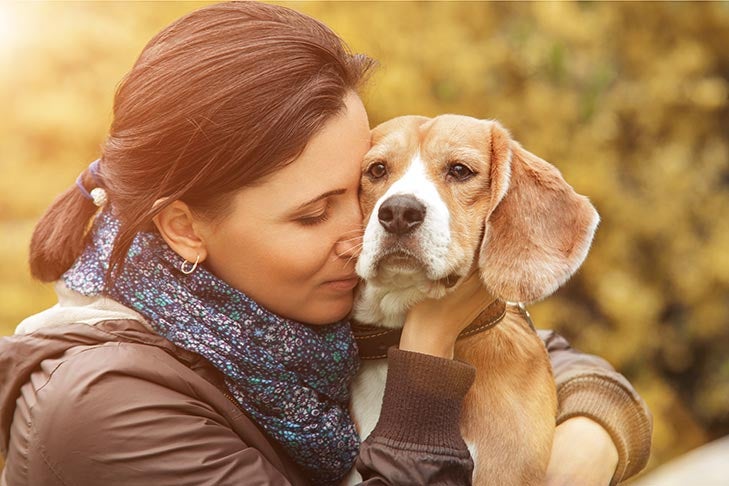For dogs and humans, winter brings the fun of snowball fights and sports like skijoring, but it also means fewer hours of daylight. And in people, that can lead to the winter blues or seasonal affective disorder (SAD), which is a type of depression with a seasonal pattern. Have you noticed your dog’s behavior change during the winter months?
As dogs share similar moods and brain chemistry with humans, it’s reasonable to think they might suffer from seasonal affective disorder, too. Read on to learn if the winter is getting your dog down and what you can do to prevent it.
Do Dogs Experience Seasonal Affective Disorder?
In humans, it’s thought that SAD results from the decreased amount of sunlight in the fall and winter. This can disrupt a person’s internal clock, lower our levels of serotonin (a brain chemical that regulates mood), and increase melatonin (a brain chemical released by the pineal gland that affects sleep). A study of sled dogs showed that the dogs’ melatonin levels were higher in the winter than in the summer, so perhaps dogs are susceptible to SAD, too.

However, there has yet to be a single study looking specifically at seasonal affective disorder in dogs. Dr. Jerry Klein, Chief Veterinary Officer for the AKC, explains, “At this time, there is no scientific evidence that dogs get seasonal affective disorder (SAD) as described in humans, though dogs also have pineal glands in their brain. The pineal gland produces melatonin, a serotonin-derived hormone that modulates sleep patterns. In humans, some people produce higher amounts of melatonin than usual in winter months, so it may be conceivable that dogs have some changes in mood. But there is no way to objectively measure or diagnose this condition in dogs.”
Dr. Klein also expects that if dogs do suffer from SAD, it would be more common in northern climates with shorter days. “In humans, SAD is described more for people living in northern parts of the world rather than sunnier, warmer climates,” he says. “One would therefore think that dogs living in the far northern climates, such as the sled working dogs would be the most affected, but no known reports or study confirms this. Perhaps because they are physically active and mentally involved.”
What Could Cause a Dog to Get the Winter Blues?
Although there has been a lack of extensive research in this area, a survey carried out in the United Kingdom by the People’s Dispensary for Sick Animals found that many owners felt their pets become more depressed during the darker winter months. The dogs seemed to sleep more and were less active. Dr. Klein points out, “Like all surveys, it was subjective and relied on the owner’s perceptions of their pets. So, it was anecdotal rather than scientific.”

Of course, there are many explanations for the survey results. People could be projecting their own winter blues onto their pets. A recent study showed that dogs can recognize their owner’s moods and distinguish between positive and negative emotions. So, if their owner is feeling down or experiencing SAD, it’s not a stretch to imagine that could impact the dog’s own emotional state. Or perhaps owners provide their pets with less mental stimulation and physical exercise in the winter.
It’s hard to know if your dog is responding to your mood, reacting to your actions, or suffering from their own emotional problems. There could even be an underlying issue with their physical health. Therefore, Dr. Klein suggests you don’t diagnose your dog with SAD on your own. “There is no scientific evidence that dogs suffer from seasonal affective disorder. If a dog seems lethargic or off their feed, it is best to have them checked by a veterinarian to make sure there is not an underlying medical issue.”
Ways to Keep Your Dog Happy and Healthy in the Winter
It’s important to provide for all your dog’s physical and emotional needs all year long. For example, take daily walks, play games together, or provide puzzle toys that will challenge your dog’s brain. Consider activities you can do inside on freezing cold days, such as scent work or a homemade agility course. Dr. Klein suggests, “Get outside with your dog and get some sunlight when possible. Find ways to stimulate your dog mentally as well as physically. And open the shades and get sunlight inside.”

Although there are treatments for humans such as light therapy and vitamin D or omega-3 supplements, don’t try these on your dog without your vet’s say-so. In fact, vitamin D can be harmful. According to Dr. Klein, “A dog being fed a well-balanced diet already receives the proper minerals and vitamins needed and should not need any supplements or additives. In fact, giving excessive vitamin D can be toxic to dogs, potentially causing fatal kidney damage as well as other medical problems. Omega-3 fatty acids have been reported to increase cognitive function but should be given on the advice of a veterinarian.”
The easiest way to keep your dog happy through the winter is to be the best owner you can be. And that goes for the summer too. As Dr. Klein says, “There is no scientific evidence that dogs suffer from seasonal affective disorder at this time. It is better to enrich our dogs’ lives through good husbandry, proper, well-balanced nutrition, adequate exercise, and mental stimulation: not just during the winter months but all year long.”
This article is intended solely as general guidance, and does not constitute health or other professional advice. Individual situations and applicable laws vary by jurisdiction, and you are encouraged to obtain appropriate advice from qualified professionals in the applicable jurisdictions. We make no representations or warranties concerning any course of action taken by any person following or otherwise using the information offered or provided in this article, including any such information associated with and provided in connection with third-party products, and we will not be liable for any direct, indirect, consequential, special, exemplary or other damages that may result, including but not limited to economic loss, injury, illness or death.

